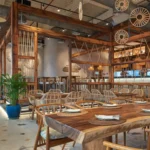Introduction
When it comes to transforming a space, choosing between DIY and professional fitouts can be a daunting decision. Both options have their unique advantages and challenges, and the best choice depends on various factors such as budget, time, skills, and desired outcomes. This comprehensive guide will delve into the details of DIY vs. professional fitouts, helping you make an informed decision for your next project.
What is a DIY Fitout?
Definition and Scope
A DIY (Do-It-Yourself) fitout refers to any renovation or customization project that you undertake on your own without professional assistance. This can range from small tasks like painting a room to more complex projects like building custom furniture or remodeling a kitchen.
Types of DIY Fitouts
DIY fitouts can vary widely depending on the scope and complexity of the project. Common types include:
- Home Decor: Painting, wallpapering, and installing shelves.
- Furniture Assembly: Building flat-pack furniture from stores like IKEA.
- Minor Renovations: Installing new light fixtures, laying flooring, or updating kitchen cabinets.
- Outdoor Projects: Building garden beds, installing decking, or creating outdoor living spaces.
What is a Professional Fitout?
Definition and Scope
A professional fitout involves hiring experts to handle the renovation or customization of a space. Professionals bring experience, specialized skills, and access to high-quality materials and tools, ensuring a polished and high-standard finish.
Types of Professional Fitouts
Professional fitouts encompass a broad range of projects, including:
- Residential Fitouts: Complete home renovations, kitchen and bathroom remodels, and custom built-ins.
- Commercial Fitouts: Office spaces, retail stores, and restaurants.
- Specialized Fitouts: Medical facilities, gyms, and educational institutions.
Cost Comparison
Initial Costs
One of the primary considerations when choosing between DIY and professional fitouts is the cost. DIY projects typically have lower initial costs since you are not paying for labor. However, the cost of materials, tools, and unforeseen expenses can add up.
Hidden Costs
DIY projects can incur hidden costs such as mistakes that require additional materials, tools you need to purchase, or time spent on trial and error. Professional fitouts may have higher upfront costs, but these usually cover comprehensive planning, quality materials, and labor.
Long-term Costs
While DIY fitouts might save you money initially, professional fitouts often provide better longevity and fewer issues over time. High-quality workmanship and materials mean less maintenance and repairs, potentially saving money in the long run.
Time Investment
Time Required for DIY Fitouts
DIY projects can be time-consuming, especially if you are learning as you go. The time commitment can vary significantly depending on the complexity of the project and your skill level.
Time Required for Professional Fitouts
Professional fitouts are generally faster since professionals have the experience, tools, and manpower to complete tasks efficiently. They follow a structured plan, minimizing delays and ensuring timely completion.
Quality of Work
Skill Level Impact
The quality of a DIY fitout largely depends on your skills and experience. While simple projects can be handled well by amateurs, more complex tasks may require a professional touch to ensure quality and safety.
Quality Control Measures
Professionals adhere to industry standards and quality control measures. Their expertise ensures a high standard of work, and they can handle unexpected challenges that arise during the project.
Tools and Equipment
DIY Tools Needed
DIY projects often require a range of tools, from basic hand tools to more specialized equipment. While some tools can be rented, others may need to be purchased, adding to the cost.
Professional Tools and Equipment
Professionals have access to advanced tools and equipment that are often too costly or impractical for DIYers to own. This access allows them to achieve superior results efficiently.
Skill Requirements
Skills Needed for DIY Fitouts
DIY fitouts require various skills, depending on the project’s scope. Basic skills include painting, measuring, and using hand tools. More advanced projects may require carpentry, plumbing, or electrical work knowledge.
Skills of Professional Fitters
Professional fitters bring a wide range of skills, honed through training and experience. They are equipped to handle all aspects of a fitout, from design to execution, ensuring a seamless process.
Safety Considerations
Safety Precautions for DIY
Safety is a crucial consideration for DIY projects. Without proper knowledge and precautions, DIYers risk accidents and injuries. It’s essential to follow safety guidelines and use protective gear.
Safety Standards for Professionals
Professionals adhere to strict safety standards and regulations. Their training ensures they are aware of potential hazards and know how to mitigate them, providing peace of mind.
Customization Options
Flexibility in DIY
DIY fitouts offer a high degree of customization and flexibility. You have complete control over the design, materials, and execution, allowing you to create a truly personalized space.
Customization with Professionals
Professionals also offer customization but with the added benefit of expertise. They can provide valuable input and suggestions, helping you achieve your vision with professional precision.
Warranty and Guarantees
DIY Fitout Warranties
DIY projects typically do not come with warranties, and any issues or mistakes are your responsibility to fix. This can lead to additional costs and frustration.
Professional Fitout Guarantees
Professional fitouts often come with warranties and guarantees on both materials and workmanship. This assurance provides peace of mind, knowing that any problems will be addressed by the professionals.
Common Mistakes in DIY Fitouts
Planning Errors
A lack of proper planning can lead to significant issues in DIY projects. Inadequate measurements, incorrect materials, or unrealistic timelines can result in costly mistakes.
Execution Mistakes
Execution mistakes are common in DIY projects. These can include poor craftsmanship, incorrect installations, or failing to follow safety guidelines, leading to subpar results and potential hazards.
Mitigation Strategies
To avoid these mistakes, thorough planning, researching best practices, and seeking advice from experienced DIYers can be helpful. Taking your time and double-checking your work can also prevent errors.
Common Issues with Professional Fitouts
Miscommunication
Miscommunication between you and the professionals can lead to misunderstandings about the project scope, budget,
or timeline. Clear, consistent communication is vital to avoid these issues.
Budget Overruns
Professional projects can sometimes exceed the initial budget due to unforeseen complications or changes in project scope. It’s important to set a realistic budget and discuss potential overruns with your contractor.
Quality Issues
While rare, quality issues can arise in professional fitouts. Ensuring you hire reputable professionals with good references can mitigate this risk.
Environmental Impact
Sustainability in DIY
DIY projects can be more sustainable if you choose eco-friendly materials and methods. Recycling, upcycling, and sourcing local materials can reduce the environmental footprint of your project.
Sustainability in Professional Fitouts
Professionals can also offer sustainable options, often having access to eco-friendly materials and technologies that may not be available to DIYers. They can help you design a green fitout that meets environmental standards.
Aesthetic Considerations
Design Options in DIY
DIY fitouts allow for complete creative freedom. You can experiment with designs, colors, and materials to create a space that reflects your personal style.
Design Options with Professionals
Professionals bring design expertise and can offer ideas you might not have considered. They can help refine your vision and ensure a cohesive, aesthetically pleasing result.
Resale Value Impact
Effect of DIY Fitouts on Property Value
Well-executed DIY projects can enhance property value, especially if they improve functionality or add desirable features. However, poor-quality work can detract from value and deter potential buyers.
Effect of Professional Fitouts on Property Value
Professional fitouts are more likely to boost property value due to the quality and appeal of the finished product. Buyers appreciate professionally done work, often seeing it as a sign of a well-maintained home.
Regulatory Compliance
Building Codes for DIY
DIY projects must comply with local building codes and regulations. Failure to do so can result in fines or difficulties when selling your property. It’s essential to research and understand these requirements before starting.
Building Codes for Professionals
Professionals are knowledgeable about building codes and ensure that all work complies with regulations. This compliance is crucial for safety and legal reasons, providing peace of mind.
Flexibility and Control
Level of Control in DIY
DIY fitouts offer complete control over every aspect of the project, from planning to execution. This control allows you to make changes and decisions as the project progresses.
Level of Control with Professional Fitouts
While professional fitouts involve collaboration, you may have less control over some aspects. However, clear communication with your contractor can ensure your vision is realized.
Stress and Hassle
Stress Levels in DIY Projects
DIY projects can be stressful, especially if they are large or complex. Balancing the project with daily responsibilities and dealing with unexpected issues can add to the stress.
Stress Levels with Professional Projects
Professional fitouts are generally less stressful since professionals handle the logistics, challenges, and execution. This approach allows you to focus on other priorities while your project is in capable hands.
Accessibility
Accessibility of DIY Fitout Resources
Resources for DIY fitouts, such as tutorials, tools, and materials, are widely accessible. Online platforms, hardware stores, and community workshops offer support for DIY enthusiasts.
Accessibility of Professional Services
Professional fitout services are also readily accessible, with numerous companies and contractors available. Researching and choosing the right professional for your project is crucial to ensure a positive experience.
Learning Opportunities
Skills and Knowledge Gained from DIY
DIY projects offer valuable learning opportunities, allowing you to develop new skills and knowledge. This experience can be empowering and rewarding, providing a sense of accomplishment.
Learning from Professionals
Working with professionals can also be educational. Observing and discussing the process with them can enhance your understanding of fitouts and inspire future projects.
Future Maintenance
DIY Maintenance Requirements
DIY fitouts often require ongoing maintenance, which you will need to handle. Being familiar with the project means you’ll know how to address any issues that arise.
Professional Maintenance Services
Professionals often offer maintenance services for the fitouts they complete. This service ensures that your space remains in excellent condition, saving you time and effort.
Choosing the Right Option for You
- Budget: Assess your financial resources and potential costs.
- Time: Evaluate how much time you can dedicate to the project.
- Skills: Be honest about your abilities and whether you can achieve the desired results.
- Scope: Determine the complexity and scale of the project.
- Quality: Decide if you need professional-level quality and longevity.
Decision-Making Tips
- List Pros and Cons: Make a detailed list of the advantages and disadvantages of each option.
- Consult Experts: Seek advice from professionals or experienced DIYers.
- Evaluate Long-term Benefits: Consider the long-term impact on your home’s value and your satisfaction.
Conclusion
Choosing between DIY and professional fitouts involves weighing various factors, including cost, time, quality, and personal preferences. Both options have their merits, and the best choice depends on your unique circumstances and goals. By considering the insights and information provided in this guide, you can make a well-informed decision that ensures a successful and satisfying fitout project.
Frequently Asked Questions (FAQs)
Q: Is a DIY fitout cheaper than hiring professionals?
A: DIY fitouts are generally cheaper initially, but hidden costs and potential mistakes can add up. Professional fitouts have higher upfront costs but offer long-term savings due to quality and durability.
Q: Can a DIY fitout match the quality of a professional job?
A: The quality of a DIY fitout depends on your skills and experience. Simple projects can match professional quality, but complex tasks often require professional expertise to achieve high standards.
Q: How long does a DIY fitout take compared to a professional fitout?
A: DIY fitouts usually take longer due to learning curves and limited time availability. Professional fitouts are typically faster as experienced teams follow structured plans and work full-time on the project.
Q: What are the common pitfalls of DIY fitouts?
A: Common pitfalls include poor planning, execution mistakes, safety hazards, and not complying with building codes. Thorough research and careful planning can help mitigate these risks.
Q: Are professional fitouts worth the investment?
A: Professional fitouts are worth the investment if you value high-quality work, time efficiency, and long-term benefits. They can also significantly enhance property value and aesthetics.
Q: Can I do some parts of a fitout myself and hire professionals for others?
A: Yes, a hybrid approach is common. You can handle simpler tasks yourself and hire professionals for complex or critical aspects, balancing cost savings with quality.






